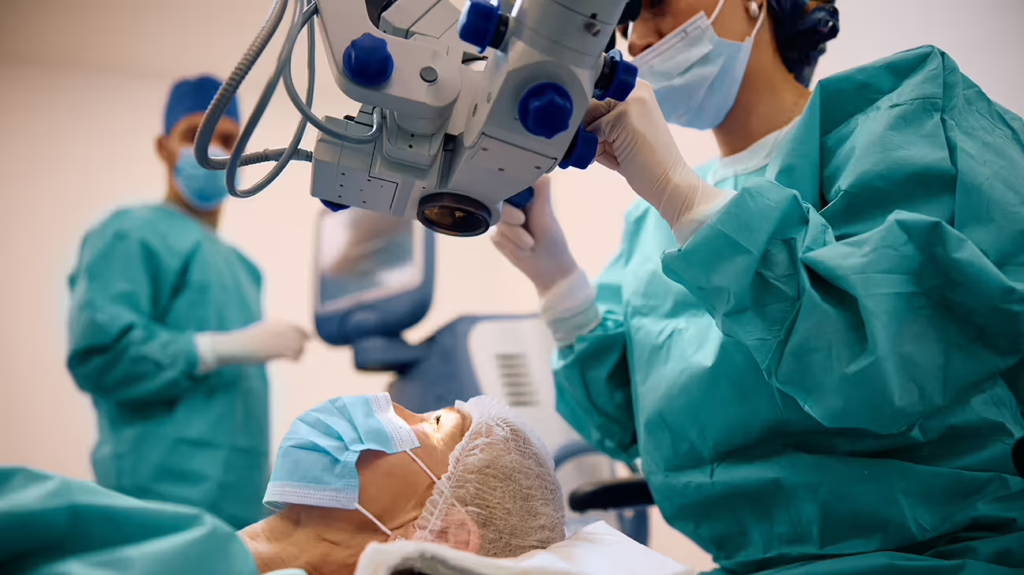Cataract eye surgery is a common procedure that can greatly improve a person’s vision. Many people may experience anxiety or uncertainty about the surgery, but understanding what to expect can help alleviate those concerns. This article will walk you through the process of cataract eye surgery, from the definition and need for the procedure to preparing for the surgery, the day of the surgery, the post-surgery experience, and common concerns and questions.
Understanding Cataract Eye Surgery
Cataract eye surgery is a transformative procedure that has helped millions of individuals regain clear vision and improve their quality of life. During this surgery, the clouded natural lens of the eye, which is typically the result of aging or other factors, is delicately removed and replaced with an artificial lens known as an intraocular lens (IOL). This innovative technique not only restores vision but also enhances visual acuity, color perception, and overall visual quality.
Definition of Cataract Eye Surgery
Modern advancements in cataract surgery techniques have made the procedure safer and more effective than ever before. Surgeons now have access to state-of-the-art equipment, such as laser technology, that allows for precise incisions and customized treatment plans tailored to each patient’s unique eye anatomy.

The Need for Cataract Eye Surgery
Cataracts, which are characterized by the clouding of the eye’s lens, can significantly impact an individual’s ability to perform daily tasks and enjoy a high quality of life. The formation of cataracts is a natural part of the aging process, but they can also develop due to factors such as genetics, eye injuries, or certain medical conditions.
While early-stage cataracts may be managed with non-surgical interventions like prescription eyeglasses or contact lenses, cataract eye surgery becomes necessary when the cloudiness in the lens progresses to a point where it interferes with a person’s vision to a significant extent. By undergoing cataract surgery, patients can experience a remarkable improvement in their vision clarity and overall visual function, allowing them to see the world with renewed clarity and vibrancy.
Preparing for Cataract Eye Surgery
Initial Consultation and Diagnosis
The first step in preparing for cataract eye surgery is to schedule an initial consultation with an ophthalmologist. This consultation is crucial as it allows the surgeon to assess the patient’s eye health and determine the best course of action. During this visit, the surgeon will conduct a comprehensive eye examination, which may include tests such as visual acuity tests, tonometry to measure eye pressure, and a slit-lamp examination to evaluate the structures of the eye. These tests help the surgeon to not only diagnose the cataract but also to assess the overall health of the eye, identifying any other potential issues that may impact the surgery.
Based on the information gathered during the consultation, the surgeon will develop a personalized treatment plan tailored to the patient’s specific needs. This plan will outline the type of cataract surgery recommended, the intraocular lens options available, and any additional considerations based on the individual’s eye health.
Read more at: Finding the Best Cataract Surgery Sydney
Pre-Surgery Instructions and Guidelines
Prior to the surgery, the ophthalmologist will provide specific instructions to follow. These instructions are designed to help optimize the outcome of the surgery and minimize the risk of complications. Patients may be advised to fast for a certain period before the procedure to reduce the risk of aspiration during surgery. Additionally, the ophthalmologist may recommend discontinuing certain medications, especially blood thinners, to lower the risk of excessive bleeding during the surgery.
It is crucial for patients to carefully adhere to these pre-surgery instructions to ensure a smooth surgical experience and promote a successful recovery. Following these guidelines can help reduce the risk of complications and improve the overall outcome of the cataract surgery. Patients should feel free to ask any questions or seek clarification on any aspect of the pre-surgery instructions to ensure they are fully prepared for the procedure.
The Day of the Surgery
Arrival and Pre-Surgery Procedures
On the day of the surgery, patients are usually instructed to arrive at the surgical center or hospital a few hours before the scheduled procedure. This allows time for final preparations, such as administrating eye drops to dilate the pupil and numbing the eye with local anesthesia. Patients are then typically taken to a pre-operative area where they will change into a surgical gown and have their vital signs checked by the nursing staff. An intravenous (IV) line may also be inserted to deliver necessary medications and fluids during the procedure. Learn more about anesthesia on https://www.hopkinsmedicine.org/health/treatment-tests-and-therapies/types-of-anesthesia-and-your-anesthesiologist
Family members or friends who accompany the patient are usually asked to wait in a designated waiting area during the surgery. This is a common practice to ensure the patient’s privacy and allow the medical team to focus on the procedure without distractions. The waiting area is often equipped with comfortable seating, reading materials, and updates on the patient’s progress provided by the surgical staff.
The Surgery Process
During cataract eye surgery, the ophthalmologist will make a small incision in the eye to access the clouded lens. The cataract is then carefully removed using advanced surgical techniques, such as phacoemulsification. Once the cataract is fully removed, the artificial intraocular lens is inserted to replace the natural lens. The surgeon will ensure proper positioning and stability of the lens before closing the incision. Throughout the procedure, the patient’s vital signs and comfort are closely monitored by the surgical team to ensure a safe and successful surgery.
Post-Surgery Experience
Immediate Aftercare and Recovery
After the surgery, patients are usually taken to a recovery area where they are monitored until the effects of the anesthesia wear off. The eye may be covered with a protective shield, and the patient will receive instructions on eye care, medications, and activities to avoid during the initial recovery period. It’s important to follow these instructions closely to promote proper healing and minimize complications.
During the immediate post-surgery period, patients may experience some common side effects such as mild discomfort, itching, or sensitivity to light. These symptoms are normal and can be managed with prescribed medications and proper rest. It is crucial for patients to refrain from rubbing or putting pressure on the operated eye to prevent any complications that may arise from excessive strain.
Long-Term Care and Follow-Up Visits
Following cataract eye surgery, regular follow-up visits with the ophthalmologist are essential for monitoring the healing process and ensuring optimal visual outcomes. These visits may include vision tests, examinations of the intraocular lens, and adjustments to any remaining refractive errors. Long-term care may also involve managing other eye conditions, such as age-related macular degeneration or glaucoma.
Moreover, in addition to the standard follow-up visits, patients are encouraged to maintain a healthy lifestyle to support overall eye health. This includes eating a balanced diet rich in antioxidants and vitamins, protecting the eyes from harmful UV rays with sunglasses, and avoiding smoking, which can exacerbate eye-related issues. By incorporating these habits into their daily routine, patients can contribute to the long-term success of their cataract surgery and preserve their visual acuity for years to come.
Common Concerns and Questions
Potential Risks and Complications
Like any surgical procedure, cataract eye surgery carries certain risks. These can include infection, bleeding, swelling, inflammation, and changes in intraocular pressure. However, serious complications are rare, and the majority of patients experience significant improvement in vision and quality of life.

Frequently Asked Questions About Cataract Surgery
1. Does cataract surgery hurt?Cataract surgery is typically painless as the eye is numbed with anesthesia. Some patients may experience mild discomfort or scratchiness after the procedure, but this is temporary and can be managed with prescribed medications.
2. How long does the surgery take?The surgery itself usually takes around 15 to 30 minutes. However, patients should expect to spend a few hours at the surgical center or hospital due to pre-surgery preparations and post-operative monitoring.
3. Will I need glasses after cataract surgery?The intraocular lens used during cataract surgery can often correct a significant amount of nearsightedness or farsightedness. However, patients may still require glasses for specific activities or minor residual refractive errors.
Now, let’s delve deeper into the potential risks and complications associated with cataract eye surgery. While it is important to be aware of these possibilities, it is equally important to remember that serious complications are rare. In fact, cataract surgery has a high success rate, with the majority of patients experiencing significant improvement in their vision and overall quality of life. Click here to read more about complications.
One potential risk of cataract surgery is infection. Although the surgical environment is carefully sterilized, there is always a small risk of infection. However, with proper post-operative care and the use of antibiotic eye drops, the risk of infection can be minimized. Additionally, bleeding and swelling are also potential complications. However, these are typically temporary and resolve on their own or with the help of prescribed medications.
Another concern that some patients may have is the possibility of changes in intraocular pressure. During cataract surgery, the natural lens of the eye is removed and replaced with an artificial intraocular lens. This change can sometimes lead to fluctuations in intraocular pressure. However, these changes are usually temporary and can be managed with eye drops or other medications.
It is important to note that while these risks exist, they are outweighed by the benefits of cataract surgery. The vast majority of patients experience improved vision, increased independence, and an enhanced quality of life after the procedure. Your ophthalmologist will thoroughly evaluate your individual case and discuss any specific risks or concerns with you before the surgery.

